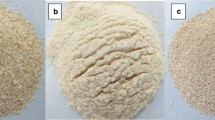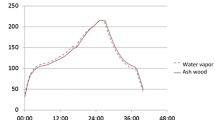Abstract
Among the widespread pests belongs Hylotrupes bajulus, which attacks mostly wooden beams in the roof of the houses. Heat sterilisation of wood is used to kill all forms of pests (eggs, larvae, adults) in solid wood materials. We compared thermal stability of heat sterilised silver fir wood to larval frass in regard to fire safety. The samples were treated at 60 and 120 °C for 10 h. Methods of chemical analysis, thermal analysis and statistical analysis were used. During the heat sterilisation of silver fir wood, only the amount of hemicelluloses decreased significantly. In larval frass samples, the holocellulose fraction decreased during the heat treatment. The hemicellulose yields in the larval frass samples were about 12% lower in average than in the wood samples. The major thermal degradation started at lower temperatures for untreated samples than for the heat-treated samples for both, silver fir wood and larval frass. Therefore, heat sterilisation does not deteriorate fire safety of wooden parts of buildings and can be used without significant alteration of the wood composition and properties.




Similar content being viewed by others
References
Kubš J, Gašparík M, Gaff M, Kaplan L, Čekovská H, Ježek J, Štícha V. Influence of thermal treatment on power consumption during plain milling of lodgepole pine (Pinus contorta subsp. murrayana). BioResources. 2016;12(1):407–18.
Esteves BM, Pereira HM. Wood modification by heat treatment: a review. BioResources. 2009;4(1):370–404.
Boonstra M. A two-stage thermal modification of wood. Nancy: Ghent University and Université Henry Poincaré; 2008.
Candelier K, Thevenon M-F, Petrissans A, Dumarcay S, Gerardin P, Petrissans M. Control of wood thermal treatment and its effects on decay resistance: a review. Ann For Sci. 2016;. doi:10.1007/s13595-016-0541-x.
Wang X. Heat sterilization of wood. In: Ross RJ, editor. Wood handbook—wood as an engineering material. Madison: U. S. Department of Agriculture, Forest Service, Forest Products Laboratory; 2010. p. 20-1–20-13.
Kacik F, Vel’kova V, Smira P, Nasswettrova A, Kacikova D, Reinprecht L. Release of terpenes from fir wood during its long-term use and in thermal treatment. Molecules. 2012;17(8):9990–9. doi:10.3390/molecules17089990.
Kacik F, Smira P, Kacikova D, Vel’kova V, Nasswettrova A, Vacek V. Chemical alterations of pine wood saccharides during heat sterilisation. Carbohyd Polym. 2015;117:681–6. doi:10.1016/j.carbpol.2014.10.065.
Kacik F, Luptakova J, Smira P, Nasswettrova A, Kacikova D, Vacek V. Chemical alterations of pine wood lignin during heat sterilization. BioResources. 2016;11(2):3442–52. doi:10.15376/biores.11.2.3442-3452.
Martinka J, Kacikova D, Hroncova E, Ladomersky J. Experimental determination of the effect of temperature and oxygen concentration on the production of birch wood main fire emissions. J Therm Anal Calorim. 2012;110(1):193–8. doi:10.1007/s10973-012-2261-2.
Fettkother R, Reddy GVP, Noldt U, Dettner K. Effect of host and larval frass volatiles on behavioural response of the old house borer, Hylotrupes bajulus (L.) (Coleoptera: Cerambycidae), in a wind tunnel bioassay. Chemoecology. 2000;10(1):1–10. doi:10.1007/s000490050001.
Chiappini E, Molinari P, Busconi M. Hylotrupes bajulus (L.) (Col., Cerambycidae): nutrition and attacked material. In: Carvalho MO, Fields PG, Adler CS, editors. Proceedings of the 10th international working conference on stored-product protection location. Estoril: Julius-Kuhn-Archiv; 2010. p. 97–103.
Busconi M, Berzolla A, Chiappini E. Preliminary data on cellulase encoding genes in the xylophagous beetle, Hylotrupes bajulus (Linnaeus). Int Biodeterior Biodegradation. 2014;86:92–5. doi:10.1016/j.ibiod.2013.09.009.
Jablonsky M, Smatko L, Botkova M, Tino R, Sima J. Modification of wood wettability (european beech) by diffuse coplanar surface barrier discharge plasma. Cellul Chem Technol. 2016;50(1):41–8.
Kang S-G, Choi C, Lee C-G, Son D-W, Yang J-K, Kang C-W, et al. A study of the heating and energy efficiency of thermally-modified firewood. J Fac Agric Kyushu Univ. 2015;60(1):197–201.
Ke J, Laskar DD, Chen S. Biodegradation of hardwood Lignocellulosics by the western poplar clearwing borer, Paranthrene robiniae (Hy. Edwards). Biomacromolecules. 2011;12:1610–20. doi:10.1021/bm2000132.
Carrier M, Loppinet-Serani A, Denux D, Lasnier J-M, Ham-Pichavant F, Cansell F, et al. Thermogravimetric analysis as a new method to determine the lignocellulosic composition of biomass. Biomass Bioenergy. 2011;35(1):298–307. doi:10.1016/j.biombioe.2010.08.067.
ASTM D1107-96 A. Standard test method for ethanol-toluene solubility of wood. West Conshohocken: ASTM International; 2013.
ASTM D1107-96 A. Standard test method for acid-insoluble lignin in wood. West Conshohocken: ASTM International; 2013.
Wise LE, Murphy M, D´Addieco AA. Chlorite holocellulose, its fractionation and bearing on summative wood analysis and on studies on the hemicelluloses. Paper Trade J. 1946;122(3):35–43.
Seifert K. Uber ein neues Verfahren zur Schnellbestimmung der Rein-Cellulose. Das Papier. 1956;10(13–14):301–6.
Francisco-Fernandez M, Tarrio-Saavedra J, Naya S, Lopez-Beceiro J, Artiaga R. Classification of wood using differential thermogravimetric analysis. J Therm Anal Calorim. 2015;120(1):541–51. doi:10.1007/s10973-014-4260-y.
Korošec RC, Lavrič B, Rep G, Pohleven F, Bukovec P. Thermogravimetry as a possible tool for determining modification degree of thermally treated Norway spruce wood. J Therm Anal Calorim. 2009;98:189–95. doi:10.1007/s10973-009-0374-z.
Gao M, Sun CY, Wang CX. Thermal degradation of wood treated with flame retardants. J Therm Anal Calorim. 2006;85(3):765–9. doi:10.1007/s10973-005-7225-3.
Yorulmaz SY, Atimtay AT. Investigation of combustion kinetics of treated and untreated waste wood samples with thermogravimetric analysis. Fuel Process Technol. 2009;90(7–8):939–46. doi:10.1016/j.fuproc.2009.02.010.
Acknowledgements
This work was supported by the VEGA agency of the Ministry of Education, Science, Research, and Sport of the Slovak Republic (No. 1/0521/15) (50%) and by the Slovak Research and Development Agency under contract No. APVV-0057-12 (50%).
Author information
Authors and Affiliations
Corresponding author
Rights and permissions
About this article
Cite this article
Kačík, F., Luptáková, J., Šmíra, P. et al. Thermal analysis of heat-treated silver fir wood and larval frass. J Therm Anal Calorim 130, 755–762 (2017). https://doi.org/10.1007/s10973-017-6463-5
Received:
Accepted:
Published:
Issue Date:
DOI: https://doi.org/10.1007/s10973-017-6463-5




